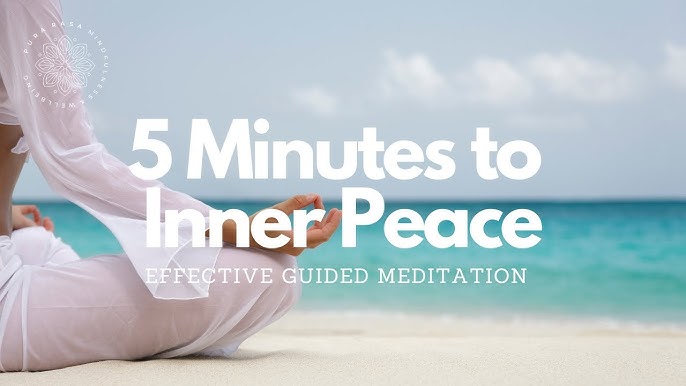Mindfulness in 5 Minutes A Guide to Inner Peace
In today’s fast-paced world, finding a moment of calm can feel like an impossible task. With constant notifications, endless to-do lists, and the pressures of daily life, our minds are often racing. But what if you could find peace, clarity, and focus in just five minutes a day? Mindfulness, the practice of being fully present in the moment, offers a simple yet powerful way to achieve this. This article explores how you can incorporate mindfulness into your life in just five minutes, offering practical techniques, benefits, and tips to make it a daily habit.
What Is Mindfulness?
Mindfulness is the art of paying attention to the present moment without judgment. It’s about observing your thoughts, feelings, and surroundings with curiosity and acceptance, rather than getting caught up in worries about the past or future. Rooted in ancient Buddhist traditions, mindfulness has gained widespread popularity in modern times, backed by science for its ability to reduce stress, improve focus, and enhance emotional well-being.
The beauty of mindfulness is its simplicity. You don’t need special equipment, a quiet room, or hours of free time. In just five minutes, you can practice mindfulness anywhere—whether you’re at home, in the office, or even stuck in traffic.
“The present moment is the only moment available to us, and it is the door to all moments.” – Thich Nhat Hanh
Why Practice Mindfulness in Just Five Minutes?
You might wonder why five minutes matters. Can such a short amount of time really make a difference? The answer is a resounding yes. Research shows that even brief mindfulness practices can have significant benefits, including:
- Reduced Stress: A 2018 study published in the journal Psychoneuroendocrinology found that short mindfulness sessions can lower cortisol levels, the hormone associated with stress.
- Improved Focus: A 2016 study in Psychological Science showed that brief mindfulness exercises can enhance attention and cognitive performance.
- Emotional Regulation: Mindfulness helps you respond to emotions with greater calm and clarity, as demonstrated in a 2017 study in Frontiers in Psychology.
- Better Sleep: Practicing mindfulness before bed can improve sleep quality, according to research in JAMA Internal Medicine (2015).
Five minutes is short enough to fit into any schedule, yet long enough to create a meaningful impact. It’s the perfect starting point for beginners and a sustainable practice for busy individuals.
How to Practice Mindfulness in 5 Minutes
Below are five simple mindfulness exercises you can do in just five minutes. Each is designed to help you reconnect with the present moment and cultivate a sense of calm.
1. The 5-Minute Breathing Exercise
Breathing is the cornerstone of mindfulness. This exercise focuses on your breath to anchor you in the present.
- Find a comfortable seated position, either on a chair or the floor.
- Close your eyes if it feels comfortable, or soften your gaze.
- Take a deep breath in through your nose for a count of four, feeling your belly expand.
- Hold the breath for a count of four, then exhale slowly through your mouth for a count of six.
- Repeat this cycle for five minutes, noticing the sensation of the breath as it moves through your body.
- If your mind wanders, gently bring it back to your breath without judgment.
This exercise is perfect for calming a racing mind and can be done anywhere, from your desk to a park bench.
2. Body Scan Meditation
A body scan helps you tune into physical sensations, releasing tension and grounding yourself in the moment.
- Sit or lie down in a quiet space.
- Close your eyes and take a few deep breaths to settle in.
- Start at the top of your head and slowly bring your attention to each part of your body—forehead, eyes, jaw, neck, shoulders, and so on.
- Notice any sensations, such as warmth, tightness, or tingling, without trying to change them.
- Spend about 30 seconds on each body part, moving downward until you reach your toes.
- End with a few deep breaths, feeling your body as a whole.
This practice is excellent for relieving physical stress and reconnecting with your body.
3. Mindful Observation
This exercise involves focusing on a single object to sharpen your awareness.
- Choose an object nearby—a flower, a coffee mug, or even your hand.
- Spend five minutes observing it closely. Notice its colors, textures, shapes, and any small details you might usually overlook.
- If your mind drifts, gently return your focus to the object.
- Reflect on how this object exists in this moment, appreciating its presence.
Mindful observation is a great way to practice being fully present, especially in busy or distracting environments.
4. The 5-4-3-2-1 Grounding Technique
This technique uses your senses to anchor you in the present, making it ideal for moments of anxiety or overwhelm.
- Take a deep breath and look around you.
- Name five things you can see (e.g., a tree, a book, a window).
- Name four things you can touch (e.g., your clothing, the chair, your hair).
- Name three things you can hear (e.g., birds, traffic, your breath).
- Name two things you can smell (e.g., coffee, fresh air).
- Name one thing you can taste (e.g., lingering toothpaste or a sip of water).
- Take a final deep breath and notice how you feel.
This exercise is quick, effective, and can be done anywhere to bring you back to the present.
5. Gratitude Reflection
Focusing on gratitude can shift your perspective and foster positivity.
- Sit quietly and take a few deep breaths.
- Think of three things you’re grateful for today. They can be as simple as a warm meal, a kind word, or a sunny day.
- Spend a minute reflecting on each, noticing how they make you feel.
- Write them down if you have time, or simply hold them in your mind.
- End by smiling and acknowledging the goodness in your life.

This practice can boost your mood and help you approach the day with a sense of abundance.
Tips for Making Mindfulness a Daily Habit
While five minutes is a great start, consistency is key to reaping the full benefits of mindfulness. Here are some tips to integrate it into your routine:
- Choose a Regular Time: Pick a specific time each day, such as first thing in the morning or before bed, to practice mindfulness.
- Create a Cue: Link your practice to an existing habit, like brushing your teeth or brewing coffee, to make it easier to remember.
- Start Small: Five minutes is perfect for beginners. As you get comfortable, you can gradually increase the time if desired.
- Use Reminders: Set a phone alarm or place a sticky note in a visible spot to prompt your practice.
- Be Kind to Yourself: If your mind wanders or you miss a day, don’t judge yourself. Simply start again the next day.
Overcoming Common Challenges
Mindfulness may sound simple, but it’s normal to face challenges, especially as a beginner. Here’s how to address some common obstacles:
- “I don’t have time.” Five minutes is shorter than a coffee break! Try practicing during a commute, lunch break, or while waiting for a meeting to start.
- “My mind keeps wandering.” This is normal! The goal isn’t to stop thoughts but to notice them and gently return to the present.
- “I don’t feel any different.” Mindfulness is a skill that develops over time. Be patient and focus on the process, not immediate results.
- “I’m too stressed to focus.” Start with shorter sessions, like one or two minutes, and use the 5-4-3-2-1 technique to ease into it.
“You can’t stop the waves, but you can learn to surf.” – Jon Kabat-Zinn
The Science Behind Mindfulness
Mindfulness isn’t just a feel-good practice; it’s backed by decades of research. Studies show that mindfulness can physically change the brain, increasing gray matter in areas associated with attention and emotional regulation (e.g., a 2011 study in Psychiatry Research: Neuroimaging). It also reduces activity in the amygdala, the brain’s stress center, helping you stay calm under pressure.
Moreover, mindfulness has been shown to improve mental health conditions like anxiety, depression, and PTSD. It’s even used in clinical settings, such as Mindfulness-Based Stress Reduction (MBSR) programs, to help patients manage chronic pain and stress.
Adapting Mindfulness for Different Lifestyles
One of the best things about mindfulness is its versatility. Whether you’re a student, a parent, or a busy professional, you can adapt these practices to fit your life:
- Students: Practice the 5-4-3-2-1 technique between classes to stay grounded during a hectic day.
- Parents: Try a gratitude reflection while your kids nap or play quietly.
- Professionals: Use the breathing exercise during a break to recharge before a meeting.
- Travelers: Do a body scan while waiting at the airport or on a long flight.
Conclusion
Mindfulness doesn’t require hours of meditation or a complete lifestyle overhaul. In just five minutes a day, you can cultivate a sense of calm, improve your focus, and enhance your well-being. By trying exercises like deep breathing, body scans, or gratitude reflections, you can discover what works best for you. Start small, be consistent, and approach the practice with an open mind. Over time, these brief moments of mindfulness can transform your relationship with yourself and the world around you.
Take the first step today. Set a timer for five minutes, try one of the exercises above, and notice how it feels to be fully present. Your mind—and body—will thank you.






